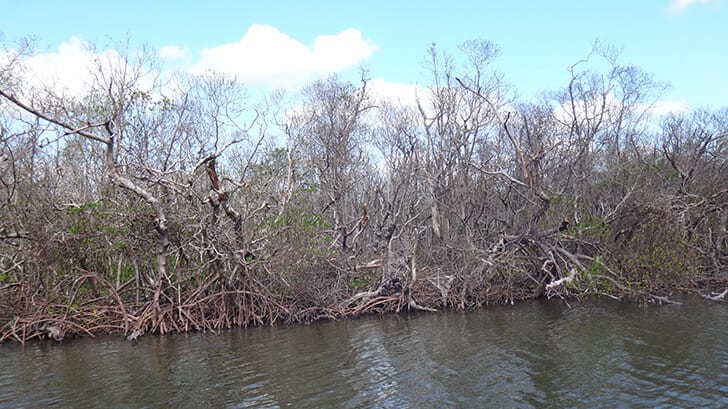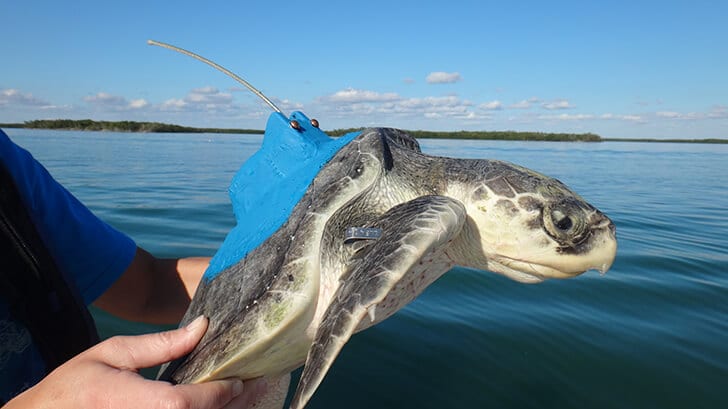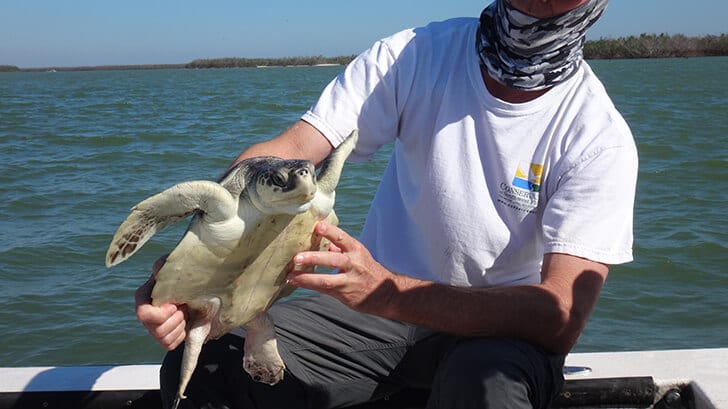By Conservancy Research Manager Dr. Jeff Schmid
On September 10, 2017, Irma made landfall on the southwest coast of Florida as a Category 3 hurricane with sustained winds measured at 115 mph (185 kph) and gusts to 130–140 mph (209–225 kph). The eye of the hurricane passed over Marco Island and continued northward to Naples, keeping the most destructive right-front quadrant to the east of these metropolitan areas. Four months later there are still signs of Irma’s fury in the urban landscape: many homes without pool cages, many more roofs with blue tarps, and huge stumps from fallen trees. Less apparent, or perhaps less sensational, is the damage to the remote coastal ecosystems in this region.

The Conservancy of Southwest Florida’s biologists have been conducting long-term research on the Kemp’s ridley turtles that inhabit the Ten Thousand Islands, an estuarine complex to the east-southeast of the Naples-Marco Island Metroplex, and our study area took a direct hit from Irma’s right eyewall. Most noticeable when traversing the maze of islands after the storm was the damage to the red mangroves. Whole trees were uprooted and now lay submerged throughout the waterways and offshore of the islands, creating navigational hazards. Those left standing were battered, broken, and stripped of their leaves. New growth has begun to bud at the end of some bare branches but recovery of the mangroves will take time.

Our research goal at the end of 2017 was to deploy satellite transmitters on Kemp’s ridleys as part of ongoing investigation of their behavior in south Florida waters during the winter months. Marine turtles are cold-blooded and will migrate to warmer waters if the water temperature drops below a certain threshold, typically around 63° F (17° C). Our tracking efforts thus far have demonstrated Kemp’s ridleys in Southwest Florida may or may not undergo seasonal migrations depending upon a given year’s climate. However, the effects of Hurricane Irma thwarted our research plans and appear to have impacted the feeding grounds of one of the most endangered marine turtle species in the world.

As mentioned, the waters of the Ten Thousand Islands are littered with mangrove debris which since have become festooned with barnacles and tunicates (sea squirts). These “twigs”, as they became affectionately known, fouled the webbing of our net every time we tried to catch a turtle. The debris also have resulted in a change in the structure of the turtles’ feeding habitat on the seafloor. Perhaps more damaging was the physical force of the Irma’s right eyewall, creating an estimated 8–10 ft. (2–3 m) storm surge and churning the waters with the high winds. Sandbars and mudflats have shifted and the suspended sediments likely smothered the benthic habitats (plants and animals living on the bottom) in which the turtles feed.

Our first clue of something amiss in the study area was the relatively low abundance of marine turtles in the aftermath of Irma. Turtles congregate in the passes between islands as they ride the tidal flow in and out. Multiple turtles can be sighted surfacing to breath on a given day provided the weather and water conditions are favorable. We were lucky to see one or two turtles a day during our recent trips, sometimes going a whole day without a sighting. Another clue came from the crab traps used to assess the availability of food as part of our Kemp’s ridley diet studies. Blue, stone, calico, and spider crabs have been collected in these waters but our traps were coming up empty following the hurricane. No groceries on the shelves for the hungry turtles.

Kemp’s ridleys occurring in the Ten Thousand Islands are immature (i.e., non-reproductive) and remain at these feeding grounds for several years. Turtles reach maturity at around 24 in. (60 cm) and, as demonstrated last year by “Shelley”, move to adult habitat in offshore waters of the Gulf of Mexico. Prior to Irma the shell lengths of Kemp’s ridleys captured in our study area ranged 12–22 in. (31–56 cm) with most in the 16–20 in. (40–50 cm) size range. The few Kemp’s ridleys observed after Irma were considerably smaller, only 11 in. (29 cm) or less. A possible explanation for the size difference is that the larger ridleys with experience feeding in this region have moved to a different area in search of food. The small ridleys we observed were new recruits and have yet to become accustomed to the feeding grounds. Deploying satellite transmitters before the Irma may have provided answers as to turtle movements after the hurricane but hindsight is 20/20. It would be difficult to plan for such an episodic weather event given the vagaries in the tracks and intensities of tropical cyclones during a given year. The last major hurricane to impact this region was Wilma in 2005.

One of the small Kemp’s ridleys observed after Irma deserves recognition as it was particularly elusive, earning the name “Houdini”, and appeared to remain in the study area from late-October through mid-December. During each of the week-long trips, in a backwater area we refer to as “Ridley Cove”, a very small turtle was observed loafing at the surface. The net was deployed around the turtle following each sighting but none of our four attempts were successful. The turtle was observed in the net during two of the attempts but did not become adequately tangled given its very casual demeanor and apparently slipped through the webbing given its small size. We came across Houdini again on our last day, bobbing at the surface without a care and taunting us as if saying “catch me if you can”, but we resisted the temptation to deploy the net a fifth time. Instead, we will let this turtle grow a little larger and perhaps its luck will run out in the not too distant future. Continuing efforts will document the recovery of the Ten Thousand Islands and how the Kemp’s ridleys adapt to catastrophic changes in their feeding grounds.
To learn more about the Conservancy of Southwest Florida’s environmental science work visit www.conservancy.org.
